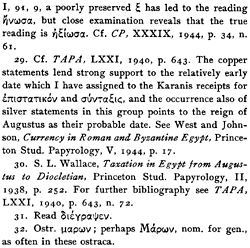us directly to a group of Karanis ostraca which bear receipts for  . 25 The majority of these also consist of two
lines. The oblique strokes, which stand at the end of the second line
of No. 295, are found frequently on Karanis ostraca of comparable
date, at the conclusion of two-line receipts, when these end in a
money statement.26 . 25 The majority of these also consist of two
lines. The oblique strokes, which stand at the end of the second line
of No. 295, are found frequently on Karanis ostraca of comparable
date, at the conclusion of two-line receipts, when these end in a
money statement.26
A fresh study of the ostracon, guided by these observations, has
yielded an intelligible text.
NO. 295 (revised)


Inv.9354

Here a certain Acusilaus, the son of Maron, has paid eight drachmas in
silver "on account of  ." ."
4. 0. Mich., I, 369
This text is a transportation receipt of the late third century A.D., issued to Manes,
|
25. TAPA, LXXI, 1940, pp. 642-5; 0. Mich., 11, 737-44
26. 0. Mich., 1, 122 (revised in TAPA, LXXI, 1940, p. 644), 124 (revised ibid.), 301, 302; 11,
701, 702, 712, 728, 737-39, 746, 748, 757, 761, 762, 767, 769.
27. Ostr.  , which accounts nicely for Amundsen's , which accounts nicely for Amundsen's
 .
28. The numerals are not completely preserved, but they are readily
reconstructed from the sizable remains. A slight doubt persists with
regard to ' .
28. The numerals are not completely preserved, but they are readily
reconstructed from the sizable remains. A slight doubt persists with
regard to ' , but this uncertainty is practically
eliminated by two considerations. (i) The special mark of the
"thousand" is unmistakable, and (2) the remnant of the numeral is hard
to adapt to any except the large-bellied form assumed by , but this uncertainty is practically
eliminated by two considerations. (i) The special mark of the
"thousand" is unmistakable, and (2) the remnant of the numeral is hard
to adapt to any except the large-bellied form assumed by  when it is combined with the supralinear "thousand"
curve. When complete, this writing of "2000" resembles an English
b. For good examples see Stud. Pal., XX, 8 1, 6, 13. The letter when it is combined with the supralinear "thousand"
curve. When complete, this writing of "2000" resembles an English
b. For good examples see Stud. Pal., XX, 8 1, 6, 13. The letter  can also be extremely deceptive when it is
mutilated. In 0. Mich., can also be extremely deceptive when it is
mutilated. In 0. Mich.,
|
|

|
|

 . 25 The majority of these also consist of two
lines. The oblique strokes, which stand at the end of the second line
of No. 295, are found frequently on Karanis ostraca of comparable
date, at the conclusion of two-line receipts, when these end in a
money statement.26
. 25 The majority of these also consist of two
lines. The oblique strokes, which stand at the end of the second line
of No. 295, are found frequently on Karanis ostraca of comparable
date, at the conclusion of two-line receipts, when these end in a
money statement.26

 ."
."


 , which accounts nicely for Amundsen's
, which accounts nicely for Amundsen's
 , but this uncertainty is practically
eliminated by two considerations. (i) The special mark of the
"thousand" is unmistakable, and (2) the remnant of the numeral is hard
to adapt to any except the large-bellied form assumed by
, but this uncertainty is practically
eliminated by two considerations. (i) The special mark of the
"thousand" is unmistakable, and (2) the remnant of the numeral is hard
to adapt to any except the large-bellied form assumed by  can also be extremely deceptive when it is
mutilated. In 0. Mich.,
can also be extremely deceptive when it is
mutilated. In 0. Mich.,
